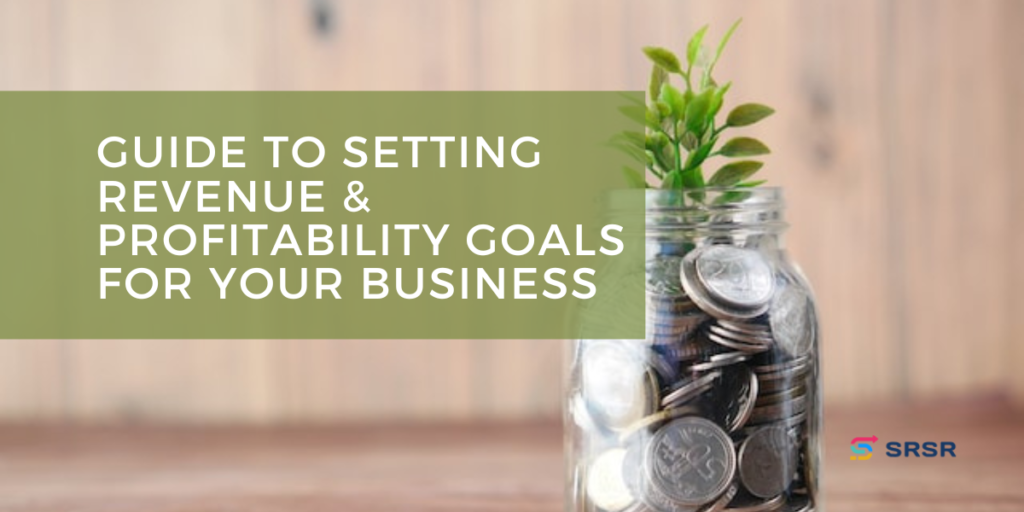Guide to setting financial goals for your business
Setting and achieving goals help form the foundation for success, both personally and professionally. If you want your small business to succeed, you need to set realistic goals and targets to motivate your team and provide the metrics needed to measure progress. In this article, we will share information about how to set two of the most important targets for your company: revenue and profitability goals.
Types of business goals
Business goals give your company direction and define what you want to achieve in the short and long term. Each goal you set for your company should be a SMART goal:
- Specific
- Measurable
- Attainable
- Relevant
- Time-bound
Although the specific goals set will vary by company, business goals often fall into five categories: growth, customer, employee development, social, and financial.
Growth goals
When you set growth goals for your company, you aim to expand part of the business.
Examples include:
- Launching new products
- Increasing your customer base
- Raising brand recognition
- Expanding to a new location
Customer goals
Customer goals are related to your interactions and relationships with potential and existing customers.
Examples include:
- Improving customer retention
- Adding a new customer support channel
- Streamlining the checkout process
- Increasing customer satisfaction
Employee-development goals
Employee-development goals focus on helping managers lead so their teams can perform at the highest level. They also aim to help your staff members achieve their own career goals and become more productive and skilled workers.
Examples include:
- Increasing worker satisfaction
- Improving employee retention
- Providing leadership and management training
- Promoting cross-training in other functional areas
Social goals
Social goals allow you to serve your area better and create social programs that benefit your local and global communities.
Examples include:
- Donating to charity
- Reducing environmental waste
- Promoting diversity, equity, and inclusion
- Operating ethically, fairly, and legally
Financial goals
Financial goals are related to your company’s money, including earning, spending, and saving.
Examples include:
- Implementing an annual budgeting process
- Accelerating customer collections
- Reducing costs
- Improving profit margins
- Increasing revenue
All types of business goals are essential for your company’s continued success. But financial targets, like revenue and profitability goals, are crucial for ensuring you have the resources to achieve your other objectives.

What are revenue goals?
Revenue is the income your company earns from the sale of goods or services. And revenue goals are the financial targets you set to ensure your company brings in enough income to support operations and cover expenses.
Importance of setting revenue goals
Setting revenue goals for your business allows you to be proactive rather than reactive. You’ll be able to plan better for the expected, giving you the resources needed for any unexpected expenses or economic downturns that come your way. By setting revenue goals, you’ll also know whether you will earn enough to meet your company’s financial obligations.
What are profitability goals?
Profits refer to your company’s net income after subtracting expenses. And profitability goals set targets for how much profit you want your business to earn each year, quarter, or month.
Importance of setting profitability goals
Setting profitability goals defines what success looks like for your company. By knowing the profit you want to achieve, you’ll be better able to predict whether you will have enough money to reinvest in your business and meet your nonfinancial goals. When your business is profitable, it can continue to grow and succeed.
Examples of financial and revenue goals
The specifics and timelines you place on your financial goals will vary depending on whether your business is a start-up that’s not yet profitable or an established customer with multiple profitable products or services.
If you need inspiration for setting your financial goals, consider the following examples, which can help you increase your revenue and profits.
Increase monthly or annual revenue
To increase your company’s revenue, you will need to increase the income you receive each month or year. There are several ways to do this, including setting targets for the number of new customers each month, increasing your prices, improving your marketing efforts, or offering discounts to encourage larger purchases. You can also increase revenue by adding more income streams through new products or services.
Increase monthly or annual profits
By increasing your profits, you will be able to retain a greater portion of your revenue. Many ways you can increase profits are similar to increasing your income, such as increasing how many customers you serve, raising prices, and encouraging customers to make larger purchases. You can also increase your profits by cutting costs through negotiating better deals with your vendors or automating certain administrative tasks, like invoicing.
Reduce customer churn
Customer churn is the percentage of customers who leave your business during a given period. Since it typically costs five times more to acquire new customers than to keep existing ones, high customer churn can cost a lot of money and eat into profits. To reduce churn, you can improve customer service, educate customers about how to use your products or make the most of your services, and offer discounts to returning customers.
Increase customer lifetime value
Customer lifetime value (CLV) represents how much a single customer spends on your products or services over their lifespan. You can increase how much each repeat customer spends by offering a referral program, sending targeted campaigns, creating a loyalty program, and providing upselling and cross-selling opportunities.
Decrease customer acquisition cost
Customer acquisition cost (CAC) refers to how much it costs to gain a new customer. It typically includes marketing campaigns, advertising costs, and salaries of your marketing and sales teams. A high CAC will eat into profits, but you can reduce costs by retargeting potential customers, improving sales funnels, and automating portions of your marketing.
Increase close rate
Your company’s close rate compares the number of sales quotes sent, demos completed, or initial meetings held with potential customers to the number of sales actually made. The more sales you close, the more revenue you will generate. You can increase your close rate by ensuring your staff thoroughly understands the benefits your products or services provide, prioritizing the leads most likely to close, and making sure the purchase process is as easy as possible.
Benefits of setting revenue and profitability goals for your business
Setting revenue and profitability goals can help ensure your company has the resources it needs to achieve its other goals. Here are a few other benefits of setting financial goals for your business.

Create a roadmap
When you know your company’s financial goals, you’ll be able to create a detailed plan to achieve those objectives. You can use your goals as a roadmap to determine how many products or services you need to sell, how much to charge for each product or service, and whether to hire additional staff. You’ll also know whether you need to decrease expenses.
Build accountability
You cannot hold a team member responsible for not selling enough if they do not know how much to sell in the first place. By providing your team with goals and asking them for feedback on related strategies, you can set expectations for their performance and hold them accountable for meeting their targets.
Improve employee recognition
When your business has overall revenue and profitability goals, you’ll be able to track which employees are meeting or exceeding their individual objectives. You can use these metrics to give praise, provide raises, and offer promotions.
Plan for the future
It can be challenging to create a budget if you do not know how much money you expect to earn. By setting revenue and profitability goals, you will have an estimate of how much to expect and can make a plan for how to use those funds.
How to set revenue and profitability goals
To set financial goals for your business, you will need to look at your revenue and profits from previous years and consider what your team can achieve. Here are some tips to help you set realistic objectives for your company.
1. Analyze past data
Before setting financial goals, it is crucial to know how well your business is doing. To do this, look at the following information from last year:
- Number of active customers
- Customer churn rate
- Total revenue
- Total expenses
- Net profit
- Close rate
- Sales cycle length
You will also want to consider all your financial obligations to determine your breakeven point, which is how much revenue you need to cover all your expenses.
This information will help you determine the minimum income you need to bring in during the year and set realistic goals for any additional revenue you want. If you are a new company without historical sales data, you can consider benchmarks for your industry and look at how much your competitors are selling each year.
2. Consider your team’s capacity
Before deciding how much you want to increase revenue and profit, you need to consider how much growth your staff can handle. If you want your current sales to increase by 50 percent, for example, your sales team may not be able to handle the additional pressure, and you may not be able to fulfill all orders. You may still be able to reach your target, but you might have to hire additional employees to do so.
3. Set annual goals
Once you have historical data, you can set annual revenue and profitability goals. Generally, there are several methods you can use to help you determine achievable targets for your business.
Last year plus some
Take last year’s revenue or profits and add a percentage. For example, if you earned $100,000 last year and want to grow revenue by 30 percent, you will set an annual goal of $130,000. This option is beneficial if your business has seen steady growth in the past.
Capacity based
Set your goals by considering how many deals your sales team can realistically close and how many orders you can fulfill. This method may mean you do not see much revenue growth over last year’s numbers, but it can be helpful if you’ve hired too soon in the past and want to avoid layoffs because you did not meet your goals.
Sales quotas
To set your revenue goal based on sales quotas, look at how much each salesperson sold last year and motivate everyone to sell more than that this year. If everyone hits their sales quotas, you have the potential to grow your revenue and profits substantially.
4. Breakdown annual goals into monthly or quarterly targets
Annual financial goals can be daunting, so you may also want to set monthly or quarterly targets. To break down your yearly goal, divide it by four to determine your quarterly objective or by 12 for your monthly objective.
Breaking your annual goal into monthly or quarterly objectives helps you take holidays and seasonality into account. You can increase the goal for months where you tend to see more sales and decrease it during slower months. It also allows you to analyze your strategies and adjust activities as needed throughout the year to give you a better chance of meeting your annual goals.
5. Determine targets for revenue-driving activities
Once you have set monthly or quarterly goals, you can determine activities needed to help you meet those objectives and set targets for each activity. For example, you might tell every salesperson to make 50 calls in a month to help them achieve their goal of $5,000 in monthly sales.
Assess your revenue and profitability planning
Financial goal setting does not stop once you’ve determined your target numbers. It’s also essential to monitor your progress, analyze your methods, and solicit feedback from your team. Throughout the year, document all actions taken to achieve your goal to determine which strategies worked well and which need improvements.
One way to assess your performance and determine if you’re on track to meet your objectives is to use key performance indicators (KPIs). KPIs analyze factors critical to measuring progress toward each goal and can be used throughout your company.

